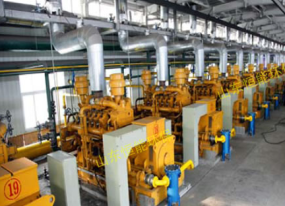欢迎进入山东91视频破解版环保能源设备有限公司
欢迎进入山东91视频破解版环保能源设备有限公司
联系电话:18678860671
服务热线:0531-69953988
联系地址:中国(山东)自由贸易试验区济南片区孙村街道经十东路33688号章锦综合保税区联东U谷科创中心5号楼 101
如何科学选择生物脱硫技术:关键要素与决策路径
 首页- 免费91视频入口资讯 > 行业资讯
首页- 免费91视频入口资讯 > 行业资讯
 2025-06-12
2025-06-12
生物脱硫技术作为环保领域的重要突破,凭借其低成本、低能耗及二次污染可控等优势,在化工、电力及市政污水处理等行业广泛应用。然而,面对多样化的技术路线,企业需结合自身需求建立科学决策框架,避免因技术错配导致运营风险。
As an important breakthrough in the field of environmental protection, biological desulfurization technology is widely used in industries such as chemical, power, and municipal sewage treatment due to its advantages of low cost, low energy consumption, and controllable secondary pollution. However, in the face of diverse technological routes, enterprises need to establish a scientific decision-making framework based on their own needs to avoid operational risks caused by technological mismatches.
一、废气特性决定技术边界
1、 The characteristics of exhaust gas determine the technological boundary
硫化物浓度分级:
Sulfide concentration classification:
低浓度场景(<1000mg/m³):优先选择生物过滤法,通过陶粒或火山岩等填料吸附硫化物,微生物在填料表面形成生物膜完成降解。
Low concentration scenario (<1000mg/m³): Biological filtration method is preferred, which adsorbs sulfides through fillers such as ceramic particles or volcanic rocks, and microorganisms form biofilms on the surface of the fillers to complete degradation.
中高浓度场景(1000-5000mg/m³):生物滴滤法更具优势,其循环喷淋系统可维持微生物活性,抗冲击负荷能力提升3倍。
Medium to high concentration scenarioses (1000-5000mg/m³): The biological drip filtration method has more advantages, as its circulating spray system can maintain microbial activity and increase shock load resistance by three times.
高浓度场景(>5000mg/m³):需采用两级生物工艺,前置厌氧反应器进行预处理,避免硫化物浓度过高抑制微生物活性。
High concentration scenario (>5000mg/m³): A two-stage biological process is required, with a pre anaerobic reactor for pretreatment to avoid excessive sulfide concentration that inhibits microbial activity.
气量波动适应性:
Adaptability to gas volume fluctuations:
对于气量波动超过±30%的工况,应选择弹性扩容设计的生物反应器,通过模块化填料单元实现处理能力动态调整。
For operating conditions with gas volume fluctuations exceeding ± 30%, a bioreactor with elastic expansion design should be selected, and dynamic adjustment of processing capacity should be achieved through modular packing units.
二、处理目标驱动技术路线
2、 Process target driven technology roadmap
排放标准差异:
Differences in emission standards:
若需满足超低排放(如SO₂<10mg/m³),需采用高效生物洗涤塔,通过三级串联结构使去除率达99%以上。
If ultra-low emissions (such as SO<10mg/m) need to be met³ )It is necessary to use an efficient biological washing tower with a three-stage series structure to achieve a removal rate of over 99%.
资源化利用场景:选择可回收单质硫的生物反应器,通过控制pH值与溶解氧浓度,使硫回收率突破85%。
Resource utilization scenario: Select a bioreactor that can recover elemental sulfur, and control the pH value and dissolved oxygen concentration to achieve a sulfur recovery rate of over 85%.

副产物处理要求:
Requirements for by-product treatment:
含氯废气需规避硫酸盐生成,选用嗜盐菌株的生物滤池,避免次生污染物腐蚀设备。
Chlorine containing waste gas should avoid the generation of sulfates, and a biological filter with halophilic bacterial strains should be selected to prevent secondary pollutants from corroding equipment.
三、场地条件制约技术实施
3、 Site conditions constrain the implementation of technology
空间布局限制:
Space layout restrictions:
占地面积紧张时,采用立式生物反应器,相同处理量下占地较传统卧式设备减少60%。
When the occupied area is tight, a vertical bioreactor is used, which reduces the occupied area by 60% compared to traditional horizontal equipment with the same processing capacity.
寒冷地区需配置伴热系统,维持反应器内温度在25-35℃,确保微生物活性。
A heat tracing system is required in cold regions to maintain the temperature inside the reactor at 25-35 ℃ and ensure microbial activity.
基础设施配套:
Infrastructure support:
缺乏循环水系统时,选择自养型生物脱硫工艺,利用硫化物作为唯一碳源,减少30%运行成本。
When there is a lack of a circulating water system, choosing a autotrophic biological desulfurization process that utilizes sulfides as the sole carbon source can reduce operating costs by 30%.
四、全生命周期成本评估
4、 Whole life cycle cost assessment
投资成本优化:
Investment cost optimization:
对比不同填料材质的寿命成本,聚丙烯多面球填料虽初期投资高20%,但使用寿命达8年,年均成本低于传统陶粒。
Comparing the life cost of different filler materials, although the initial investment of polypropylene multi-faceted ball filler is 20% higher, its service life can reach 8 years, and the average annual cost is lower than that of traditional ceramic particles.
能耗控制策略:
Energy consumption control strategy:
配置变频风机与溶解氧在线监测仪,根据进气浓度实时调节供氧量,节能率提升至25%。
Configure a variable frequency fan and a dissolved oxygen online monitor to adjust the oxygen supply in real-time based on the intake concentration, increasing the energy saving rate to 25%.
五、技术验证与风险管控
5、 Technical validation and risk management
小试/中试必要性:
The necessity of small/medium scale trials:
针对复杂成分废气,必须开展200小时连续试验,验证微生物菌群抗毒性及处理稳定性。
For complex component exhaust gases, a 200 hour continuous test must be conducted to verify the microbial community's resistance to toxicity and treatment stability.
应急预案设计:
Emergency plan design:
设置备用活性炭吸附装置,在生物系统故障时切换,确保排放连续达标。
Set up a backup activated carbon adsorption device to switch in case of biological system failure, ensuring continuous emission compliance.
生物脱硫技术的科学选型需构建“废气特性-处理目标-场地条件-经济性”四维决策模型。企业应优先明确硫化物浓度、排放标准及空间限制等核心约束条件,通过小试试验验证技术可行性,再结合全生命周期成本分析选择最优方案。随着合成生物学技术的发展,基因编辑菌株的应用将进一步提升生物脱硫的效率与适应性,为企业环保升级提供更多元的技术路径。
The scientific selection of biological desulfurization technology requires the construction of a four-dimensional decision-making model consisting of "exhaust gas characteristics treatment objectives site conditions economy". Enterprises should prioritize clarifying core constraints such as sulfide concentration, emission standards, and spatial limitations, verify technical feasibility through small-scale experiments, and then select the optimal solution based on full lifecycle cost analysis. With the development of synthetic biology technology, the application of gene edited strains will further enhance the efficiency and adaptability of biological desulfurization, providing more diverse technological paths for enterprise environmental upgrades.
本文由生物脱硫友情奉献.更多有关的知识请点击:http://www.ruanj.com91视频破解版将会对您提出的疑问进行详细的解答,欢迎您登录网站留言.
This article is a friendly contribution from biogas purification For more information, please click: http://www.ruanj.com We will provide detailed answers to your questions. You are welcome to log in to our website and leave a message
相关免费91视频入口